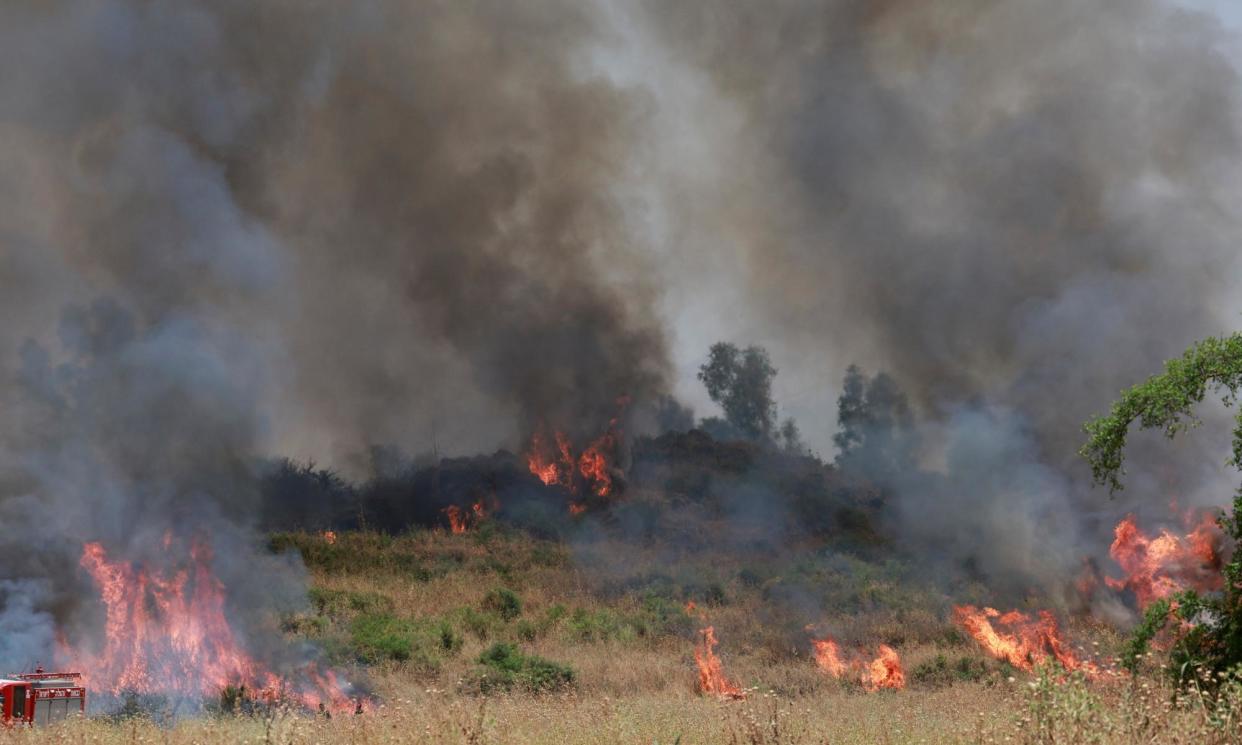Israeli talk of war with Hezbollah almost certainly fresh attempt at deterrence

A warning from Israel’s foreign minister, Israel Katz, that a decision on “all-out war” with Hezbollah in southern Lebanon is coming soon is almost certainly a fresh attempt at deterrence on his part – not least because both sides well understand how devastating full hostilities would be.
The reality is that Hezbollah, an ally of Iran, is a more powerful adversary than Hamas in Gaza. It is estimated to have between 30,000 and 50,000 fighters available and a similar number in reserve – plus between 120,000 and 200,000 unguided missiles and rockets, plus attack and reconnaissance drones.
Assaf Orion, a former brigadier-general in the Israel Defense Forces and its chief of strategy between 2010 and 2015, estimates that Hezbollah has “tens times the arsenal of Hamas” and implies that any conflict would be a similar order of magnitude greater than the hostilities in Gaza after 7 October.
Katz, speaking on Tuesday, was responding to a nine-minute video of drone footage released by Hezbollah, showing detail of military and residential sites in Israel’s port of Haifa, 25 to 30 miles from the border, at least some of which was shot “during the past 72 hours”, according to one Israeli assessment, based on the presence of a particular Israeli military vessel in the city’s naval base.
Surveillance drone footage is not itself a deadly military capability, but the “we know where you live” tone of the film was intended to unsettle northern Israeli citizens and suggest that Hezbollah could launch a barrage of attacks in the hope of overwhelming Israel’s Iron Dome and David’s Sling short- and medium-range air defences.
A key concern is the risk of a miscalculation that leads to a sudden conflict. Hezbollah and Israel have been trading blows since Hamas launched its attack eight months ago, and Hezbollah has insisted it will not stop unless there is a ceasefire in Gaza. But as the campaign in the south reaches what the IDF says are its final stages, violence in the north has been stepping up as sharply as the rhetoric.
Last week an airstrike killed Taleb Sami Abdallah, the most senior Hezbollah commander to be killed by Israel since last October, prompting the Lebanese militant group to fire 215 rockets into northern Israel last Wednesday and another 100 the day after, the heaviest barrages in the past eight months. Although there were no reports of fatalities, two IDF soldiers were injured.
The last all-out war between the two, in 2006, escalated from an incident when Hezbollah guerrillas killed three IDF soldiers, injured two more and captured two others after a cross-border raid that was rapidly interpreted by Israel as an act of war. A devastating air campaign into Lebanon failed to suppress rocket attacks from Hezbollah and a brief ground invasion followed in a conflict that lasted for a month.
An estimated 155,000 civilians have already been displaced on both sides of the border. Israel evacuated 60,000 citizens living within 5km, while a further 20,000 have abandoned homes further away voluntarily, and another 75,000 have been forced to leave the villages of southern Lebanon while the tit-for-tat continues.
Sarit Zehavi, the founder of Alma, an education centre that focuses on the security of Israel’s northern border, said the current position was unsustainable: “There is already a second front. Galilee [in northern Israel] is under daily attack from UAVs, rockets and missiles. The average now is 90 every week. There is already a war up there on a low scale. The question is how it will be solved – whether through a full-scale war or some kind of ceasefire.”
But Orion cautions that an attempt at a military solution would need a combination of aerial bombing and a ground invasion that would require “the whole of the IDF’s available forces”, allowing for a limited presence in Gaza and a security presence in the West Bank. A rapid incursion would also ask a lot of IDF troops fatigued by eight months of long and bloody fighting in the south.
Hezbollah’s stockpile of missiles and drones,Orion argues, could result in “dozens or hundreds of destruction areas” in Haifa and around the north and “depending on how the population responds, there could be hundreds of fatalities” and a threat to Israeli infrastructure, particularly given that the Lebanese group is believed to have access to up to 400 guided missiles.
These are grim speculations, and any conflict would prompt an immediate diplomatic crisis, raising questions of whether Iran would seek to support Hezbollah and the spectre of a wider Middle East conflict that the US has been desperate to avoid.
Lina Khatib, a Middle East expert at the Chatham House thinktank, says the combination of diplomatic pressure and military reality ultimately restrains both sides. “Both Israel and Hezbollah routinely prepare for potential escalations. However, neither side currently benefits from an all-out war.”

 Yahoo News
Yahoo News 
